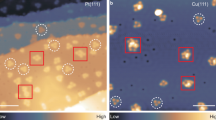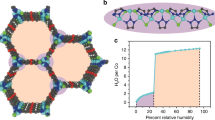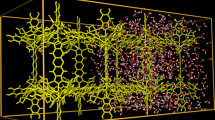Abstract
Studies of the structure of supported water clusters provide a means for obtaining a rigorous molecular-scale description of the initial stages of heterogeneous ice nucleation: a process of importance to fields as diverse as atmospheric chemistry, astrophysics and biology. Here, we report the observation and characterization of metal-supported water hexamers and a family of hydrated nanoclusters—heptamers, octamers and nonamers—through a combination of low-temperature scanning tunnelling microscopy experiments and first-principles electronic-structure calculations. Aside from achieving unprecedented resolution of the cyclic water hexamer—the so-called smallest piece of ice—we identify and explain a hitherto unknown competition between the ability of water molecules to simultaneously bond to a substrate and to accept hydrogen bonds. This competition also rationalizes previous structure predictions for water clusters on other substrates.
This is a preview of subscription content, access via your institution
Access options
Subscribe to this journal
Receive 12 print issues and online access
$259.00 per year
only $21.58 per issue
Buy this article
- Purchase on Springer Link
- Instant access to full article PDF
Prices may be subject to local taxes which are calculated during checkout





Similar content being viewed by others
References
Ball, P. H2O: A Biography of Water (Weidenfeld & Nicolson, London, 1999).
Murray, B. J., Knopf, D. A. & Bertram, K. The formation of cubic ice under conditions relevant to Earth’s atmosphere. Nature 434, 202–205 (2005).
Abbatt, J. P. D. et al. Solid ammonium sulfate aerosols as ice nuclei: A pathway for cirrus cloud formation. Science 313, 1770–1773 (2006).
Doxey, A. C., Yaish, M. Y., Griffith, M. & McConkey, B. J. Ordered surface carbons distinguish antifreeze proteins and their ice-binding regions. Nature Biotechnol. 24, 852–855 (1996).
Mitsui, T., Rose, M. K., Fomin, E., Ogletree, D. F. & Salmeron, M. Water diffusion and clustering on Pd(111). Science 297, 1850–1852 (2002).
Verdaguer, A., Sacha, G. M., Bluhm, H. & Salmeron, M. Molecular structure of water at interfaces: Wetting at the nanometer scale. Chem. Rev. 106, 1478–1510 (2006).
Ranea, V. A. et al. Water dimer diffusion on Pd{111} assisted by H-bond donor-acceptor tunneling exchange. Phys. Rev. Lett. 92, 136104 (2004).
Meng, S., Xu, L. F., Wang, E. G. & Gao, S. W. Vibrational recognition of hydrogen-bonded water networks on a metal surface. Phys. Rev. Lett. 91, 059602 (2003).
Thiel, P. A. & Madey, T. E. The interaction of water with solid-surfaces—fundamental-aspects. Surf. Sci. Rep. 7, 211–385 (1987).
Henderson, M. A. The interaction of water with solid surfaces: Fundamental aspects revisited. Surf. Sci. Rep. 46, 5–308 (2002).
Morgenstern, K. & Rieder, K. H. Formation of the cyclic ice hexamer via excitation of vibrational molecular modes by the scanning tunneling microscope. J. Chem. Phys. 116, 5746–5752 (2002).
Morgenstern, K. & Nieminen, J. Intermolecular bond length of ice on Ag(111). Phys. Rev. Lett. 88, 066102 (2002).
Morgenstern, M., Michely, T. & Comsa, G. Anisotropy in the adsorption of H2O at low coordination sites on Pt(111). Phys. Rev. Lett. 77, 703 (1996).
Yamada, T., Tamamori, S., Okuyama, H. & Aruga, T. Anisotropic water chain growth on Cu(110) observed with scanning tunneling microscopy. Phys. Rev. Lett. 96, 036105 (2006).
Cerdá, J. et al. Novel water overlayer growth on Pd(111) characterized with scanning tunneling microscopy and density functional theory. Phys. Rev. Lett. 93, 116101 (2004).
Nauta, K. & Miller, R. E. Formation of cyclic water hexamer in liquid helium: The smallest piece of ice. Science 287, 293–295 (2000).
Nutt, D. R. & Stone, A. J. Adsorption of water on the BaF2(111) surface. J. Chem. Phys. 117, 800–807 (2002).
Meng, S., Wang, E. G. & Gao, S. W. Water adsorption on metal surfaces: A general picture from density functional theory studies. Phys. Rev. B 69, 195404 (2004).
Park, J. M., Cho, J. H. & Kim, K. S. Atomic structure and energetics of adsorbed water on the NaCl(001) surface. Phys. Rev. B 69, 233403 (2004).
Sebastiani, D. & Delle Site, L. Adsorption of water molecules on flat and stepped nickel surfaces from first principles. J. Chem. Theor. Comp. 1, 78–82 (2005).
Yang, Y., Meng, S. & Wang, E. G. Water adsorption on a NaCl (001) surface: A density functional theory study. Phys. Rev. B 74, 245409 (2006).
Doering, D. L. & Madey, T. E. The adsorption of water on clean and oxygen-dosed Ru(001). Surf. Sci. 123, 305–337 (1982).
Ogasawara, H. et al. Structure and bonding of water on Pt(111). Phys. Rev. Lett. 89, 276102 (2002).
Michaelides, A. Density functional theory simulations of water-metal interfaces: Waltzing waters, a novel 2D ice phase, and more. Appl. Phys. A 85, 415–425 (2006).
Michaelides, A., Alavi, A. & King, D. A. Different surface chemistries of water on Ru{0001}: From monomer adsorption to partially dissociated bilayers. J. Am. Chem. Soc. 125, 2746–2755 (2003).
Clay, C. & Hodgson, A. Water and mixed OH/water adsorption at close packed metal surfaces. Curr. Opin. Solid State Mater. Sci. 9, 11–18 (2005).
Haq, S., Clay, C., Darling, G. R. & Hodgson, A. Growth of intact water ice on Ru(0001) between 140 and 160 K: Experiment and density-functional theory calculations. Phys. Rev. B 73, 115414 (2006).
Schiros, T. et al. Structure of water adsorbed on the open Cu(110) surface: H-up, H-down, or both? Chem. Phys. Lett. 429, 415–419 (2006).
Tersoff, J. & Hamann, D. R. Theory of the scanning tunneling microscope. Phys. Rev. B 31, 805 (1985).
Ireta, J., Neugebauer, J. & Scheffler, M. On the accuracy of DFT for describing hydrogen bonds: Dependence on the bond directionality. J. Phys. Chem. A 108, 5692–5698 (2004).
Dahlke, E. E. & Truhlar, D. G. Improved density functionals for water. J. Phys. Chem. B 109, 15677–15683 (2005).
Adamo, C. & Barone, V. Toward reliable density functional methods without adjustable parameters: The PBE0 model. J. Chem. Phys. 110, 6158–6170 (1999).
Stephens, J., Devlin, F. J., Chabalowski, C. F. & Frisch, M. J. Ab-initio calculation of vibrational absorption and circular-dichroism spectra using density-functional force-fields. J. Phys. Chem. 98, 11623–11627 (1994).
Xantheas, S. S., Burnham, C. J. & Harrison, R. J. Development of transferable interaction models for water. II. Accurate energetics of the first few water clusters from first principles. J. Chem. Phys. 116, 1493–1499 (2002).
Morgenstern, K. & Nieminen, J. Imaging water on Ag(111): Field induced reorientation and contrast inversion. J. Chem. Phys. 120, 10786–10791 (2004).
Filhol, J.-S. & Bocquet, M.-L. Charge control of the water monolayer/Pd interface. Chem. Phys. Lett. 438, 203–207 (2007).
Nilsson, A. et al. The hydrogen bond in ice probed by soft x-ray spectroscopy and density functional theory. J. Chem. Phys. 122, 154505 (2005).
Michaelides, A., Alavi, A. & King, D. A. Insight into H2O-ice adsorption and dissociation on metal surfaces from first-principles simulations. Phys. Rev. B 69, 113404 (2004).
Michaelides, A., Ranea, V. A., de Andres, P. L. & King, D. A. General model for water monomer adsorption on close-packed transition and noble metal surfaces. Phys. Rev. Lett. 90, 216102 (2003).
Ayotte, P., Weddle, G. H. & Johnson, M. A. An infrared study of the competition between hydrogen-bond networking and ionic solvation: Halide-dependent distortions of the water trimer in the X-center dot(H2O)(3), (X=Cl, Br, I) systems. J. Chem. Phys. 110, 7129–7132 (1999).
Näslund, L.-A. et al. Direct evidence of orbital mixing between water and solvated transition-metal ions: An oxygen 1s XAS and DFT study of aqueous systems. J. Phys. Chem. A 107, 6869–6876 (2003).
Robertson, W. H., Diken, E. G., Price, E. A., Shin, J.-W. & Johnson, M. A. Spectroscopic determination of the OH- solvation shell in the OH-center dot(H2O)(n) clusters. Science 299, 1367–1372 (2003).
Cabera-Sanfelix, P., Holloway, S., Kolasinski, K. W. & Darling, G. R. The structure of water on the (0001) surface of graphite. Surf. Sci. 532, 166–172 (2003).
Lin, C. S. et al. Simulation of water cluster assembly on a graphite surface. J. Phys. Chem. B 109, 14183–14188 (2005).
Mehlhorn, M., Gawronski, H., Nedelmann, L., Grujic, A. & Morgenstern, K. An instrument to investigate femtochemistry on metal surfaces in real space. Rev. Sci. Instrum. 78, 033905 (2007).
Segall, M. D. et al. First-principles simulation: Ideas, illustrations and the CASTEP code. J. Phys. Condens. Matter 14, 2717–2744 (2002).
Perdew, J. P., Burke, K. & Ernzerhof, M. Generalized gradient approximation made simple. Phys. Rev. Lett. 77, 3865 (1996).
Frisch, M. J. et al. Gaussian 03. Revision C.02 (Gaussian, Inc., Wallingford, 2004).
Acknowledgements
We are grateful to M. Scheffler for valuable discussions. K.M. is grateful to the Deutsche Forschungsgemeinschaft (DFG) for a Heisenberg scholarship. This work was conducted as part of a EURYI scheme. See www.esf.org/euryi.
Author information
Authors and Affiliations
Corresponding author
Ethics declarations
Competing interests
The authors declare no competing financial interests.
Rights and permissions
About this article
Cite this article
Michaelides, A., Morgenstern, K. Ice nanoclusters at hydrophobic metal surfaces. Nature Mater 6, 597–601 (2007). https://doi.org/10.1038/nmat1940
Received:
Accepted:
Published:
Issue Date:
DOI: https://doi.org/10.1038/nmat1940
This article is cited by
-
Identification of a common ice nucleus on hydrophilic and hydrophobic close-packed metal surfaces
Nature Communications (2023)
-
Ortho-para interconversion of nuclear states of H2O through replica transition state: prospect of quantum entanglement at homodromic Bjerrum defect site
Journal of Molecular Modeling (2023)
-
Model of confined water self-diffusion and its application to proton-exchange membranes
Ionics (2021)
-
Origins of fast diffusion of water dimers on surfaces
Nature Communications (2020)
-
Predicting heterogeneous ice nucleation with a data-driven approach
Nature Communications (2020)



